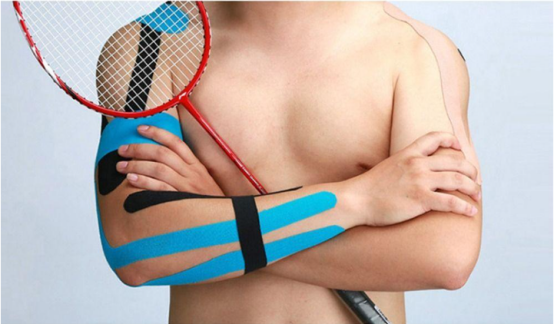What is physical therapy tape?
Physical therapy tape is a new type of elastic kinesiology tape. We often see sports athletes wearing physical therapy tape during competitions. Compared with traditional zinc oxide tape, It has high elasticity (can stretch more than 60% of the original length). Its most significant advantage is that it can not only adapt to the movement of muscles but also does not restrict the normal motion of the body’s activities.

What is the basic principle of Physical therapy tape?
1. Physical therapy tape promotes blood circulation.
By creating wrinkles, a gap is created between the skin and subcutaneous tissue, making lymphatic circulation smoother, reducing fluid accumulation in the body, relieving pain, and accelerating recovery from injury.
2. Elastic therapeutic tape can increase body surface perception and relieve pain.
Stimulating the skin surface and receptors can excite or inhibit the central nervous system, achieving analgesic effects. When a specific body part is hit or causes pain for other reasons, the most instinctive reaction is to hold (or cover or press) the painful area with your hands to relieve the pain. Kinesiology tape holds the painful area like a hand, relieving patients of pain.
3. Physical therapy tape supports and stabilizes the muscles.
Because cotton kinesiology tape is highly elastic and does not restrict the everyday activities of the limbs, this feature is incomparable with traditional tape. Therefore, muscle tape plays a better role in sports protective effect.
4. Elastic therapeutic tape has a positive regulating effect on tendons.
It causes them to be lightly stimulated so that the body constantly adjusts its balance in response to external stimulation, alleviating symptoms.
5. Kinesiology tape has the function of regulating skin temperature.
Elastic therapeutic tape is made of cotton, which can promote blood circulation and regulate the skin’s constant temperature.

What conditions require the use of Physical therapy tape?
1. Illnesses caused by muscle imbalance. Such as muscle pain, muscle strain, muscle spasms, weakened muscle strength, joint pain, etc.
2. Sickness caused by incorrect posture. Such as cervical spondylosis, lumbar muscle strain, scoliosis, low back fasciitis, etc.
3. Blood circulation and lymphatic return problems. If congestion, edema, synovitis, joint effusion, etc.
4. Ligament, tendon, and joint injuries. Such as ligament strain, ligament tear, tendonitis, tendon end disease, arthritis, joint degenerative changes, etc.
5. Fascial adhesion or nodule formation. Such as shoulder and back fasciitis, psoas my fasciitis, gluteal fasciitis, muscle soreness, etc.
6. Wrong exercise posture. Such as the tennis elbow, tennis leg, and golfer’s elbow.
7. Neurological problems. Cervical spondylosis, lumbar disc herniation, etc.
If you are a sports enthusiast, vigorous exercise may cause your shoulders, elbows, knees, calves, ankles, etc. to be harmed by diseases. It is essential to learn how to use kinesiology tape properly.
How to use Physical therapy tape?
1. The function of elastic therapeutic tape mainly relies on its elastic recoil, so the direction of the recoil force is the direction of our taping.
2. Do not apply tension at the head or end, as this will affect the adhesiveness of the tape.
3. The two ends of the elastic therapeutic tape should be cut into arc shapes so you will not roll it up quickly.

physical therapy tape can mainly used in two aspects.
First, during the recovery period during non-exercise, it allows muscles to recover, repairs muscle damage caused by over-contraction or over-stretching, and plays a role in relaxing muscles, called relaxing tape. It is also called elastic therapeutic tape;
Another situation is to promote muscle contraction during exercise or to help muscles play their due role, so it is called kinesiology tape, also known as muscle tape.
After reading this article, I believe you have a specific understanding of physical therapy tape. If you still need to know more, please contact Aupcon, a leading kinesiology tape manufacturer in China




